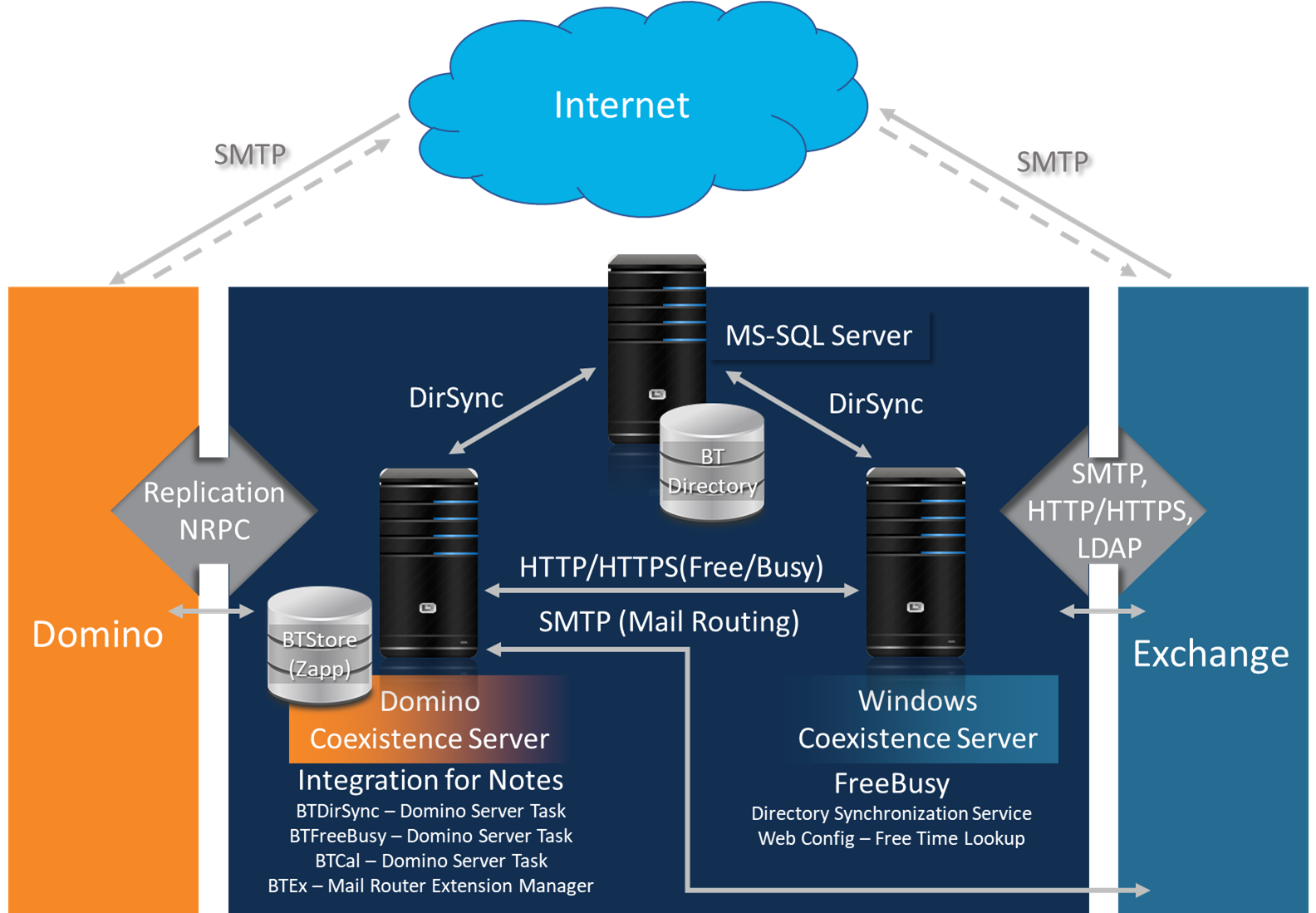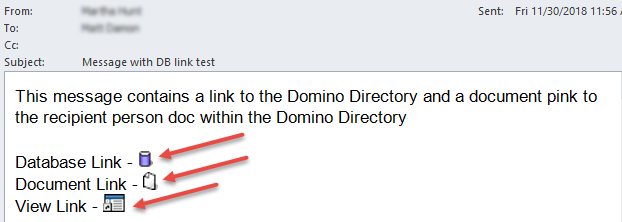A coexistence environment can contain as little as one server (if only managing message and calendar workflow), but an ideal environment would contain a minimum of three servers as illustrated below:
Domino Coexistence Server
Windows Coexistence Server (for FreeBusy only)
SQL Coexistence Server (for Directory Sync Pro)
An optional component of Integration for Notes is Zero-touch Application Remediation (ZApp), which allows Outlook users to view and act on email-enabled Notes applications. This is configured on the Domino coex server.

In the illustration above, one of the components is the Domino Coexistence Server, which is responsible for supporting coexistence server tasks at the Domino end of the environment. These server tasks include:
Messaging/calendaring/application coexistence
Free/busy lookup (see the FreeBusy user guide)
It also houses several Domino databases used by Integration for Notes, and, if ZApp is enabled, the BTStore database.
The Windows Coexistence Server, on the other hand, is designed to support coexistence on the Exchange side with free/busy lookups.
The SQL Coexistence Server (in the middle of the illustration) can be a dedicated or shared SQL Server and contains a SQL database which is used for name and email address directory synchronization between Domino and Exchange.
Messaging
The coexistence environment facilitates mail flow between Domino and Exchange. It allows you to configure how email addressing is handled between the two platforms. It also manages calendar workflow between Domino and Exchange users, allowing them to schedule/update/reschedule and cancel single occurrence and recurring meetings irrespective of their migration status or email platform.
|
|
Items migrated with Notes Migrator will not have access to the full coexistence functionality until a post-migration workflow has been implemented. Refer to Appendix I: Processing Repeating Meetings for information regarding unsupported items. |
Directory Synchronization Using Directory Sync Pro
Directory Sync Pro for Notes automates the manual work of keeping Exchange and Domino environments in sync, by performing one off or scheduled synchronization of new and changed data from one or more Domino Directories and Windows Active Directory
FreeBusy
A Domino environment implements its calendar free/busy queries differently from the way Exchange does…which means that natively, one environment cannot see the availability of users in the other environment. To make the two environments communicate with each other, Integration for Notes uses FreeBusy, which works seamlessly with other components of the coexistence environment, so that Notes users can view the free/busy status of Exchange users…and vice versa. (For more information, see the FreeBusy user guide.)
A coexistence environment can contain as little as one server (if only managing message and calendar workflow), but an ideal environment would contain a minimum of three servers as illustrated below:
Domino Coexistence Server
Windows Coexistence Server (for FreeBusy only)
SQL Coexistence Server (for Directory Sync Pro)
An optional component of Integration for Notes is Zero-touch Application Remediation (ZApp), which allows Outlook users to view and act on email-enabled Notes applications. This is configured on the Domino coex server.

In the illustration above, one of the components is the Domino Coexistence Server, which is responsible for supporting coexistence server tasks at the Domino end of the environment. These server tasks include:
Messaging/calendaring/application coexistence
Free/busy lookup (see the FreeBusy user guide)
It also houses several Domino databases used by Integration for Notes, and, if ZApp is enabled, the BTStore database.
The Windows Coexistence Server, on the other hand, is designed to support coexistence on the Exchange side with free/busy lookups.
The SQL Coexistence Server (in the middle of the illustration) can be a dedicated or shared SQL Server and contains a SQL database which is used for name and email address directory synchronization between Domino and Exchange.
Messaging
The coexistence environment facilitates mail flow between Domino and Exchange. It allows you to configure how email addressing is handled between the two platforms. It also manages calendar workflow between Domino and Exchange users, allowing them to schedule/update/reschedule and cancel single occurrence and recurring meetings irrespective of their migration status or email platform.
|
|
Items migrated with Notes Migrator will not have access to the full coexistence functionality until a post-migration workflow has been implemented. Refer to Appendix I: Processing Repeating Meetings for information regarding unsupported items. |
Directory Synchronization Using Directory Sync Pro
Directory Sync Pro for Notes automates the manual work of keeping Exchange and Domino environments in sync, by performing one off or scheduled synchronization of new and changed data from one or more Domino Directories and Windows Active Directory
FreeBusy
A Domino environment implements its calendar free/busy queries differently from the way Exchange does…which means that natively, one environment cannot see the availability of users in the other environment. To make the two environments communicate with each other, Integration for Notes uses FreeBusy, which works seamlessly with other components of the coexistence environment, so that Notes users can view the free/busy status of Exchange users…and vice versa. (For more information, see the FreeBusy user guide.)
Integration for Notes offers a number of improvements over native Domino/Exchange message and calendar interoperability, including:
User friendly display name formatting for mail messages and calendar invitations
Support for repeating meetings, including updates, invitee tracking and room and resource reservations
Customizable user alerts when updates to repeating meetings cannot be processed correctly due to native Domino and Exchange differences
Database, view, and doc links are displayed in Outlook the same way they are displayed in Notes

Notes-specific email elements are fully supported and actionable in Outlook, including:
Embedded forms
Link and action hotspots, text pop-ups and buttons
Mail flow redundancy and clustering
Integration for Notes is designed to:
Achieve high-fidelity exchange of mail and calendar data by utilizing the SMTP protocol with MIME and iCAL encoding of Notes Rich Text data
Increase reliability with redundant mail flow paths for SMTP-based email data exchange
Provide reliable free/busy schedule lookups between Exchange and Domino users
Improve the appearance of addresses in the From, To, and CC fields, replacing unfriendly email addresses with user-friendly display names
Identify and intercept Exchange or Domino initiated invitations that the opposing system can’t support, and send customizable notifications to the meeting chairs
Allow Outlook users to book meetings using Domino rooms or resources